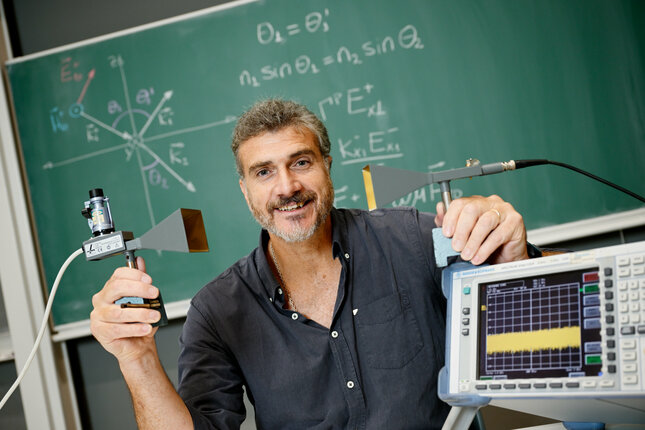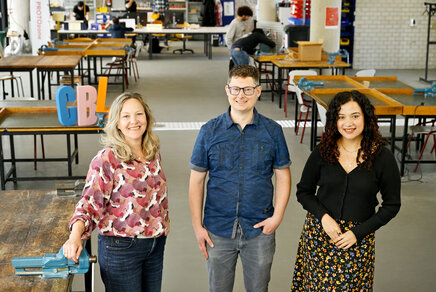‘Thanks to the bio-sketch, I can show how I add value’
Ramiro Serra, associate professor at the department of Electrical Engineering, shares his experiences with the biographical sketch.

Ramiro Serra experiences the biographical sketch as a big step forward in career development. He was promoted to associate professor-1 at the department of Electrical Engineering. For that assessment interview, he used the biographical sketch to define to which extent he wanted to be rewarded for his teaching and educational efforts, research achievements, and his performance in leadership and impact.
Ramiro Serra is a researcher at the Electrical Energy Systems group. He was among the first in his department to use the biographical sketch for his Assessment Committee (BAC) interview.
In the biographical sketch, scientists reflect by category (research, education, leadership, and impact) on what they have done in the past. And describe a vision for themselves in the future.
Not an archetype researcher
“For me, that offered advantages because I’m not the archetype researcher,” Serra says. He’s a passionate teacher and educational innovator in addition to his research. “But it’s harder to get proper credit for that.”
Ways to assess
Serra nuances, “It’s not that people don’t appreciate me or thwart my career opportunities. What has been missing until now are ways you can assess scientists who deviate from the traditional research-dominated path.”
“The Recognition and Rewards program, and thus the bio-sketch, helps me tremendously. It gives me tools to explain to others who I am and how I can add value.”
No time but recognition
In his biographical sketch, Serra divides his work. He devotes 40 percent of his time to education, 25 percent to research, 25 percent to leadership, and 10 percent to impact.
When asked to compose his biographical sketch, Serra initially struggled to understand how these now self-defined percentages that apply to each category should be interpreted.
Should they represent efforts spent in each category? Measured how and averaged in which period of time? Then, Serra realized the best is to interpret these percentages as a weight factor for his recognition in each category, not to account for the proportion of time spent on each category.
“Maybe I excel in a task and can do it very quickly. Or maybe I take longer because I’m not so good at it. Those percentages represent the recognition I want, not the time spent on it. I decide how heavily I want the different components to weigh in my assessment.”
Facts and vision
In each category, you use the biographical sketch to reflect on your work and describe your vision for the future. You back up that reflection with facts in a so-called fact sheet.
“Before the introduction of the biographical sketch, you had to submit a teaching statement if you wanted promotion, but you didn’t have to provide any evidence for that. There were no tools, making assessing people, particularly on their teaching efforts, rather difficult.”
Serra says the same has been the case for leadership and impact until now. He feels this change is a good thing. “It forces you to back up your claims with facts. How do you prove that you excel in education? You can do that, for example, by winning an award, publishing a paper, or winning an educational grant. But also being a member of the examination board or developing a course with high student numbers.”
Philosophizing about sketch
During his BAC session, Serra reflected on the term sketch. “That word is cleverly chosen, and it also got me thinking. Because a sketch reflects that it’s a continuous process; it’s not finished yet but gives direction. And it’s personal and different for everyone.”
“I am a different academic than someone else, but I am also a different Ramiro now than I was ten years ago and of the Ramiro ten years from now. That remains subject to change. A sketch tells a story of an idea, a vision that has already started, and it is clear, however, not fully fulfilled or accomplished yet.”
“Making sketches is one of the first things I teach my students. If they can’t visualize their idea, I advise them to sketch it. That helps to get it clear in your head and communicate it to others. Words are sometimes not enough to communicate - a sketch can help.”
Tips
Serra is a storyteller. In his teaching, in his research. “Stories bring things to life. My head never stands still, and I constantly reflect on my actions. So reflecting on myself was not difficult.”

Make sure you have a good story to tell about yourself.
Associate professor Ramiro Serra
“When you stand before a BAC, your story must be compelling. The people reading your biographical sketch need to see YOU. You are the subject; make sure it matters.”
He realizes this is not easy. “You must thoroughly examine who you are and what you want in the future. That can be quite a challenging task. Therefore, find a buddy to help you in your reflection process toward your BAC. That can be your partner, a friend, or a colleague. As long as someone challenges you by asking questions and to whom you can present your doubts. See it as an opportunity to discover and express yourself.”
Written by
More on our strategy


![[Translate to English:]](https://assets.w3.tue.nl/w/fileadmin/_processed_/0/4/csm_OAY%202024%20Site%20Picture%201080x720%20px_e2e67b3e60.jpg)